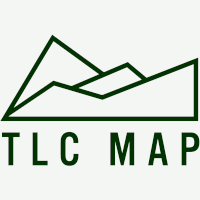Significant updates were made to TLCMap that consolidated gazetteer capabilities with a new user experience. The Gazetteer of Historical Australian Places tool, the centrepiece of TLCMap, was integrated as the homepage to improve user experience. A visitor arriving at the site would now see a map focused on their own location.
This update provided a suite of visualisations for layers meeting a variety of basic needs. There was clustering for large datasets, lines sorted by date or by route for journeys and biographical information, a simpler, better looking timeline, and a ‘fly through’ of 3D terrain.
This made the layers much more useful and engaging, and rounded out TLCMap as a richer end to end tool for creation, discovery and engagement with humanities digital maps.
The information in the layers linked back to TLCMap and, if applicable, to the original source. You could share the link just by cutting and pasting the URL of the map into a message and you could embed the map in your web page (see ‘help’).
This followed on from the major reworking of the underlying data structure, to provide a solid foundation for further development and integration, and to make the contributions process easier and more forgiving in v3.0. Needless to say, there remained plenty to do in bug fixes, tweaks and improvements, and in some major additions such as realising the prototypes for basic statistics and analysis, text processing and archiving.
Some partners layers were used in development but were held back from the map as those projects were finished. All are welcome to contribute humanities map layers.
Gazetteer of Australian Historical Places, v3.0. November, 2021
This upgrade involved some major revisions to the database structure and core functionality. It was important to get this right as GHAP was a foundation on which other things were to be built. We expected to carry on through 2022 and beyond (grant pending). If the grant didn’t come through we intended to find a way to carry on because of TLCMap’s great potential and clear, wide ranging benefits to researchers and the public. We were exploring industry and institutional partnerships. With this GHAP upgrade in place, other enhancements, features and visualisations could follow in more rapid succession.
- policy for Unique IDs of records in TLCMap established.
- better handling of ‘title’ and ‘placename’ ambiguity.
- more forgiving handling of dates.
- improved data structure for layer metadata.
- addition of ‘content warning’ field.
- improve register to create a login workflow for ‘least surprise’.
- addition of ‘type’ for broad categorisation to ease use in future.
- better handling of ‘Extended Data’ (extra non-standard columns in spreadsheet) in the database and in export and visualisation.
- better handling of the important ‘Linkback’ URL.
- improvements to 3D viewer.
- consistent and complete handling of download and web services for search results and layers as CSV, KML or GeoJSON.
- better layout of search results, to avoid scrolling of wide tables.
- better nomenclature such as the term ‘layers’ to reflect the entire purpose and name ‘TLCMap’, instead of ‘datasets’, Gazetteer of *Places* not placenames.
- more forgiving handling fixes to CSV import, handling issues with dates, multiline cells, non UTF8 CSVs.
- link individual places to Trove searches in ‘Visualise’ drop down.
- migration from MySQL to Postgres for compatibility with UON, use of PostGIS, and future seamless integration with Spatiotemporal Metrics.
- miscellaneous bug fixes.
- revised documentation, including simpler beginners introduction.
Some Priority Enhancements that were to Follow:
- Better UI for adding and editing of individual items in the layer, within GHAP.
- Ingest of select cultural layers
- Visualisations: ordinal, journeys, timelines, Temporal Earth.
- STMetrics Integration for one-click statistics and cluster analyse (or maybe 2 or 3 clicks TBH).
- Code snippet for embed map in another web page.
- Handling overlapping dots on the map.
- Download and re-upload updated data to preserve persistent ids, instead of deleting and creating new ones.
Some Aims for the Future (pending funding):
- add multiple layers and/or search result to a single map.
- integration and enhancements of prototypes, such as Recogito, cyclical widgets, STMetrics, Ordinal visualisations, etc.
- more ingest of cultural collections and library materials.
- mining text with natural language processing.
- mapping across media and collections.
- Hotspot analysis prototype developed
- Extensive use case testing for data ingest
- Gazetteer migrated to Postgres for compliance with UON IT, and to make PostGIS available, in particular to close integration with Spatiotemporal metrics.
- Improvements to Quick Coordinates.
- Problems with Recogito were encountered during the launch. About 1 month of development time is required to polish our enhancements for contribution back to the main branch. Recogito withdrawn from service till this can occur.
- Spatiotemporal metrics prototype functional, but withdrawn until it can be integrated with GHAP. STMetrics requires data upload to process, which should happen directly into GHAP, instead of 2 places. This has the added benefit that those wanting metrics also contribute a layer at the same time. GHAP migrated to Postgres to enable this.
- Heurist deployed their UI enhancements.
- Gazetteer User Contributions
- Temporal Earth Integration
- Functional prototypes:
- Spatiotemporal Metrics – basic statistics
- Spatiotemporal Metrics – cluster analysis
- Quick Coordinates
- Recogito enhancements
- Cyclical Time
- Ordinal Time
Gazetteer of Historical Australian placenames launched.
- Processed ~300,000 records of which only approx. 1/3 had well formatted coordinates. We extracted coordinates from free text fields for ~200,000 records.
- Search and filter interface.


